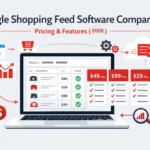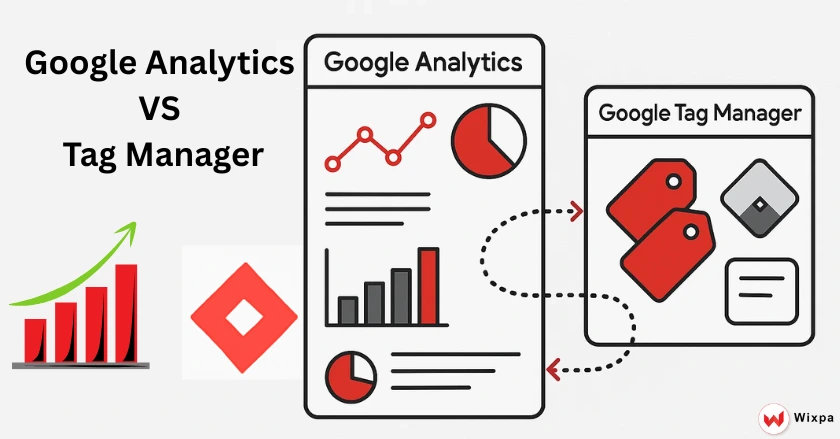
Choosing between Google Analytics vs Tag Manager can be tough for beginners. Both tools are key for tracking your website’s performance, but they serve different purposes in your digital marketing toolkit.
Understanding the differences in Google Analytics vs Tag Manager helps you pick the best tool for your needs and budget. If you’re a new marketer or small business owner, this guide provides the essential information to help you begin with confidence.
Quick Summary
Google Analytics tracks how visitors interact with your website. It gives you detailed reports on page views, user interactions, and conversion rates. Google Tag Manager makes it easy to add tracking codes and marketing tags to your site. You can make changes without touching the source code. Many businesses gain from using both tools together. They work well together for complete web analytics and smooth tag management.
Purpose of Google Analytics
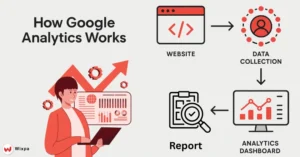
Google Analytics serves as your website’s data collection and analysis hub. This web analytics platform tracks how visitors engage with your site. It records everything from their first click to the final conversion.
The tool tracks essential metrics like page views, session duration, and user demographics. Small business owners appreciate how Google Analytics 4 tracks customer journeys on different devices and platforms.
Understanding Google Tag Manager
Google Tag Manager is a tag management system. Adding tracking codes to your website becomes quick and simple. Instead of manually adding JavaScript code to every page, you can manage all your marketing tags from one central container.
This method saves time and lowers the chance of breaking your site. You can add new tracking pixels or third-party tags more safely. Website owners find GTM useful for managing multiple marketing campaigns. It helps with different tracking solutions.
How Analytics and Tag Manager Complement Each Other
- Google Tag Manager simplifies the technical setup of Google Analytics tracking codes.
- Google Analytics processes and reports on the collected data.
- Using both tools keeps your source code clean.
- This integration delivers a deeper understanding of user activity.
- Essential for digital marketing strategies that must have accurate data collection and analysis.
What Makes Google Analytics Essential?
Google Analytics excels at turning raw user data into actionable business insights. The platform’s reports show you which pages do well. They also reveal where visitors come from and what actions they take on your site.
Overview of GA4
Google Analytics 4 represents the latest evolution of Google’s analytics platform. GA4 differs from Universal Analytics. It uses an event-based tracking model. This model gives deeper insights into user interactions and behavior across platforms.
The new interface emphasizes user-friendly reporting. It simplifies tracking form submissions, button clicks, and other key engagement events. Combined, they provide detailed insights into user actions. This helps them optimize their campaigns better.
Tracking User Behavior and Engagement
GA4 tracks how users move through your website and engage with your content. You can find out which pages keep attention the longest. You’ll see where users leave your conversion funnel. It also shows you which content your audience engages with most.
This user behavior data helps you identify opportunities to improve your website’s experience. If you see high bounce rates on certain pages, you can improve them. This helps keep visitors engaged longer.
Data Analysis and Reporting Capabilities
- Offers pre-built reports for common business questions.
- Provides the freedom to design reports that fit your goals.
- Analyzes data ranging from basic page views to complex multi-touchpoint conversion paths.
- Includes real-time data monitoring for live website performance tracking.
- Real-time data is crucial during product launches and marketing campaigns. It provides immediate feedback.
Key Features of Google Tag Manager
Google Tag Manager makes website tracking easier. It uses a simple container system. The platform eliminates the necessity for developers to update code by hand. Now, you can add new tracking features.
Simplified Tag Management
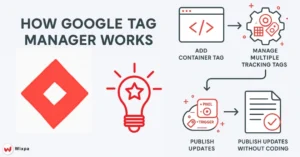
GTM’s container tag system allows you to manage all your tracking codes from one dashboard. You can control Facebook Pixel, Google Ads conversion tracking, and custom HTML tags together.
- Add new tracking codes without editing your website’s source code.
- Test tags before publishing to confirm their functionality.
- Version control lets you roll back changes if something goes wrong.
- Preview mode shows exactly what data each tag will collect.
Third-party Tool Integration
The platform supports hundreds of pre-built tag templates for popular marketing tools. You can easily add tracking pixels from Facebook, Twitter, LinkedIn, and other platforms. You don’t need any custom coding.
This flexibility makes it simple to adapt your tracking setup as your marketing stack grows. GTM makes it easy to add new advertising platforms or switch analytics tools. It manages the technical setup with ease.
Understanding Container Tags
A Manager container serves as the foundation for all your tracking activities. This single JavaScript code goes on your website once. It then manages all future tag deployments without manual intervention.
Think of the container as a digital filing cabinet that organizes all your tracking codes. When someone visits your site, the container checks which tags to fire. It does this based on your triggers and variables.
When Should You Use Google Analytics?
Google Analytics offers great insights into website performance and user behavior. The platform is great at answering key questions. It helps you understand your audience, check content effectiveness, and improve conversion rates.
Best Fit for In-depth User Insights
Use Google Analytics to get detailed reports. You can learn about visitor demographics, traffic sources, and engagement patterns. The platform offers the analysis you need to make smart, data-driven choices about your website and marketing.
Small business owners find GA4 useful. It helps them understand seasonal trends. They can identify key traffic sources and optimize conversion funnels using real user data.
Common Use Cases for GA4
GA4 gives you powerful tools for detailed website tracking and reporting. Here are the most common applications:
- E-commerce tracking: Watch shopping cart abandonment, product performance, and buy behavior.
- Content analysis: Find which blog posts, pages, or resources get the most engagement and conversions.
The platform is great at tracking goal completions. This includes newsletter signups, contact form submissions, and sales transactions.
When does Google Tag Manager make sense?
Google Tag Manager is key for flexible, efficient tag management. You won’t need developers all the time. The platform helps businesses with many marketing campaigns and tracking tools.
Ideal for Marketing Tracking Flexibility
GTM works best if you often add or change tracking codes for various marketing campaigns. You don’t need to update your website’s code every time. You can add new tags to the GTM interface in a short amount of time.
This flexibility is key for businesses. It helps them try out different ad platforms. They can track seasonal trends and collaborate with marketing agencies. This is great for quick tag deployment.
Typical Applications for GTM
Google Tag Manager excels in situations where managing tags is complicated. It helps keep your marketing efforts fast and efficient.
Multi-platform advertising: Track pixels for Google Ads, Facebook, LinkedIn, and more all in one place. Event Tracking: Set up custom tracking for
- Button clicks
- Form submissions
- Video views
- Other user actions
A/B testing: Use different tracking setups for each website version or marketing test.
The platform makes it easier to follow privacy rules. It gives you centralized control over all data collection on your website.
How Google Analytics and Tag Manager work together
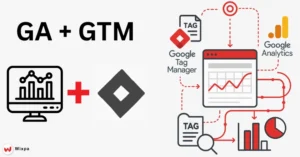
Google Analytics and Tag Manager work together to make website tracking effective and thorough. GTM handles the technical implementation while GA processes and analyzes the collected data.
Benefits of Using Both Tools Together
- Using both platforms together helps drop common tracking issues.
- Google Tag Manager ensures the Analytics tracking code activates properly on every page.
- Provides flexibility to add extra tracking as needed.
- Improves website performance by consolidating many tracking codes into one container.
- Manages all scripts with precision through GTM’s streamlined system.
Streamlining workflow and enhancing efficiency
The combined approach cuts down the time to set up and manage website tracking. Marketing teams can set up new tracking configurations right away. They don’t need to wait for developers or website updates.
You can improve data quality by using GTM’s testing features. Test things out before you publish changes to your Analytics setup. This stops issues like duplicate tracking or broken events. These problems can mess up your data.
Common Misconceptions
Many people mix up Google Analytics and Google Tag Manager. This can cause mistakes in setup and lost opportunities. Understanding these differences helps you use each tool with greater effectiveness.
Differences Between GA and GTM
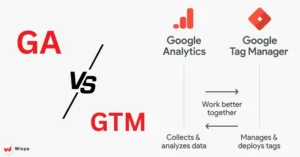
When looking at Google Analytics vs Tag Manager, it’s important to understand that both tools play different but complementary roles in your marketing tech stack. Google Analytics focuses on data collection, processing, and reporting, while Google Tag Manager manages the deployment of tracking codes. Think of GTM as the delivery system and GA as the analysis engine together, Google Analytics vs Tag Manager provide complete website tracking and valuable business insights.
Clarifying Overlapping Features
While both tools handle aspects of website tracking, they don’t duplicate functionality. Google Tag Manager gives basic reports on tag performance. However, it can’t match the in-depth analysis that Google Analytics offers.
Google Analytics has some tag management features, but they aren’t as advanced as GTM’s tag deployment and testing tools. Each tool excels in its specialized area while supporting the other’s functionality.
Privacy Compliance Considerations
Google Analytics and Tag Manager help you follow data privacy rules like GDPR and CCPA. Knowing these capabilities lets you track user behavior while keeping their privacy intact. This way, you can gather vital business insights.
Ensuring Data Privacy with GA and GTM
Google Analytics 4 has privacy controls. These controls manage many compliance needs on their own, so you don’t have to step in. The platform can work without cookies if needed. It also offers ways to anonymize user data collection.
Google Tag Manager supports privacy compliance through its consent management features. You can set tags to activate only after users give consent. This helps ensure that your tracking respects visitors’ privacy choices.
Adhering to legal standards and regulations.
Both platforms offer configuration options to help you meet various privacy regulations. You can adjust your data collection methods. This applies to both local work and serving customers in various regions. This helps you meet legal requirements.
The key is to know your compliance obligations. Set up both tools in the correct manner. Many businesses gain from talking to privacy experts. They help ensure tracking setups meet all necessary standards.
Impact on Website Performance
Using Google Analytics and Tag Manager can boost your website’s performance. This is better than traditional tracking methods. But, poor configuration can slow down your site and hurt user experience.
Google Tag Manager loads in a manner that does not block the rendering of the page. This means tracking codes won’t block your website’s main content. This method keeps page load times quick. It also ensures that data collection is accurate for every user interaction.
The platform also provides performance insights that help you optimize your tracking setup. You can locate slow-loading tags. Then, adjust your settings to boost page speed and enhance user experience.
Pro Tips for Implementation Success
To set up Google Analytics and Tag Manager, focus on details. Also, test everything step by step. Begin with basic tracking. Then, add more advanced features when you feel at ease with both platforms.
- Test all tracking implementations in GTM’s preview mode before publishing changes.
- Use consistent naming conventions for tags, triggers, and variables to maintain organization.
- Document your tracking setup to help team members understand your configuration.
- Regular audits ensure your tracking remains accurate as your website evolves.
Think about teaming up with skilled digital marketing experts nearby. They can boost your setup for better results and ensure compliance.
Making the Right Choice for Your Business
When deciding on Google Analytics vs Tag Manager for your business, it’s not always about picking one over the other. In fact, most businesses benefit from using both tools together. Google Analytics helps you understand your audience and optimize your website, while Google Tag Manager ensures accurate and efficient data collection.
A smart approach is to start with Google Analytics 4 for basic website tracking and reporting, then add Google Tag Manager to simplify tag management and enhance tracking. By combining Google Analytics vs Tag Manager, you can maintain high data quality, scale your setup as your business grows, and gain deeper insights for smarter decision-making.
FAQ
Google Tag Manager makes adding and managing tags much easier without editing code. This reduces errors, saves time, and gives marketers more control. Tools like Wixpa Google Tag Manager app help businesses streamline tag management while improving accuracy and flexibility.
No—GTM doesn’t replace Google Analytics. Instead, it works alongside it. GTM manages and deploys tracking codes, while Google Analytics collects and analyzes data. Together, they offer powerful insights.
Yes, Google Tag Manager and Google Analytics work best together. GTM deploys the tags, and GA tracks the data. Using them together provides cleaner tracking and richer insights. Platforms like Wixpa make integration even smoother for e-commerce stores.
Not at all. GTM was designed so marketers can manage tracking without depending on developers. It speeds up implementation and cuts down technical delays. For Shopify store owners, the Tag Manager app makes setup quick and accessible for beginners.
The biggest benefits are faster tag deployment, reduced developer dependency, improved accuracy, version control, and stronger security. It saves time and boosts efficiency. With solutions like Wixpa businesses can unlock the full potential of GTM and manage tags effortlessly.


